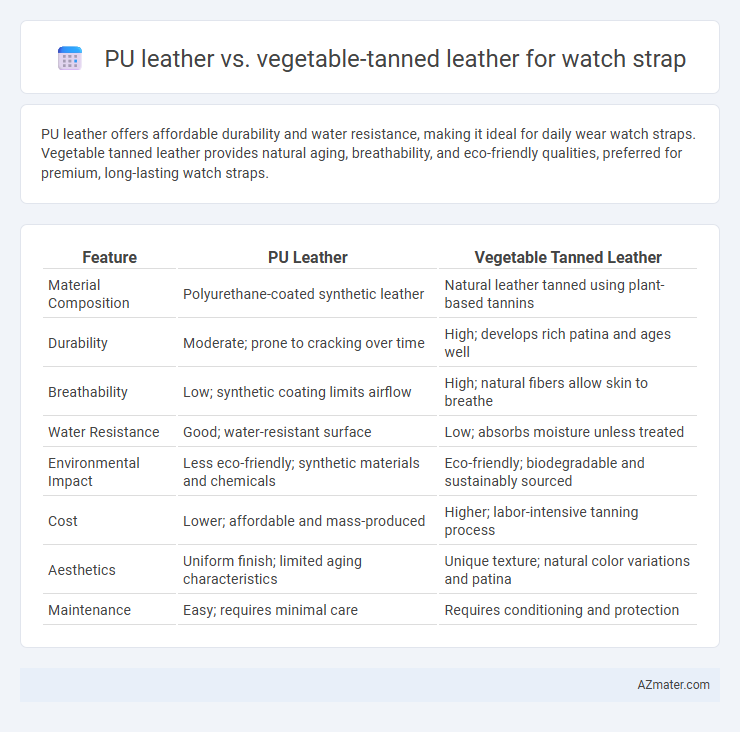PU leather offers affordable durability and water resistance, making it ideal for daily wear watch straps. Vegetable tanned leather provides natural aging, breathability, and eco-friendly qualities, preferred for premium, long-lasting watch straps.
Table of Comparison
| Feature | PU Leather | Vegetable Tanned Leather |
|---|---|---|
| Material Composition | Polyurethane-coated synthetic leather | Natural leather tanned using plant-based tannins |
| Durability | Moderate; prone to cracking over time | High; develops rich patina and ages well |
| Breathability | Low; synthetic coating limits airflow | High; natural fibers allow skin to breathe |
| Water Resistance | Good; water-resistant surface | Low; absorbs moisture unless treated |
| Environmental Impact | Less eco-friendly; synthetic materials and chemicals | Eco-friendly; biodegradable and sustainably sourced |
| Cost | Lower; affordable and mass-produced | Higher; labor-intensive tanning process |
| Aesthetics | Uniform finish; limited aging characteristics | Unique texture; natural color variations and patina |
| Maintenance | Easy; requires minimal care | Requires conditioning and protection |
Introduction to PU Leather and Vegetable Tanned Leather
PU leather, a synthetic material made by coating fabric with polyurethane, offers durability, water resistance, and affordability, making it a popular choice for watch straps. Vegetable tanned leather, crafted through an eco-friendly process using natural tannins from tree bark and plants, provides a unique patina, breathability, and long-lasting strength. Both materials cater to varying preferences in style, maintenance, and sustainability for watch strap wearers.
Composition and Manufacturing Process
PU leather watch straps consist of a synthetic polyurethane coating applied to a fabric base, offering uniform texture and water resistance through a fully mechanical and chemical manufacturing process. Vegetable tanned leather straps are crafted from animal hides treated with natural tannins derived from tree bark and plant extracts, providing durability and unique patina via a time-intensive, traditional tanning method. The composition of PU leather relies on petrochemical polymers, while vegetable tanned leather uses organic materials, impacting breathability and aging characteristics in watch strap production.
Environmental Impact
PU leather watch straps generally have a lower environmental footprint during production since they avoid the water-intensive and chemical-heavy tanning processes of traditional leather. However, PU leather is derived from synthetic polymers like polyurethane, which are non-biodegradable and contribute to microplastic pollution and long-term environmental persistence. Vegetable-tanned leather, while involving resource-intensive processes, is biodegradable and uses natural tannins from tree bark, making it a more sustainable option when sourced from ethical and well-managed livestock industries.
Durability and Longevity
PU leather watch straps provide moderate durability with resistance to water and scratches but tend to wear out and crack over time due to synthetic material breakdown. Vegetable tanned leather, made from natural tannins, offers superior longevity and develops a unique patina that enhances with age, making it more resilient to daily wear and tear. Investing in vegetable tanned leather ensures a durable, long-lasting watch strap that improves aesthetically, whereas PU leather may require more frequent replacement.
Comfort and Wearability
PU leather watch straps offer enhanced softness and flexibility, providing immediate comfort with minimal break-in time, making them ideal for daily wear. Vegetable tanned leather straps develop a unique patina over time and conform to the wrist shape, offering increased breathability and natural moisture absorption for long-term comfort. Both materials differ in durability; PU leather resists water and stains, whereas vegetable tanned leather ages gracefully but requires proper maintenance to maintain wearability.
Aesthetic Differences
PU leather watch straps offer a smooth surface with consistent color and texture, often appearing more uniform and polished compared to vegetable tanned leather. Vegetable tanned leather develops a unique patina over time, showcasing natural variations, rich hues, and a more organic, vintage look. The aesthetic appeal of vegetable tanned leather lies in its evolving character and depth, whereas PU leather maintains a static, synthetic appearance.
Maintenance and Care
PU leather watch straps require minimal maintenance, needing only occasional wiping with a damp cloth to remove dirt and prevent cracking, while avoiding excessive moisture and direct sunlight to maintain flexibility. Vegetable tanned leather demands more careful upkeep, including regular application of leather conditioners or oils to preserve its natural oils, prevent drying, and develop a rich patina over time. Both materials benefit from avoiding prolonged exposure to water and harsh chemicals, but vegetable tanned leather's organic composition makes it more susceptible to damage without proper care.
Price Comparison
PU leather watch straps typically cost significantly less than vegetable tanned leather straps, with prices often ranging from $10 to $30 compared to $50 to $150 for vegetable tanned options. The lower price of PU leather results from its synthetic manufacturing process, which requires fewer resources and less time compared to the natural, labor-intensive tanning process of vegetable tanned leather. Despite the price difference, vegetable tanned leather offers superior durability and develops a unique patina over time, often justifying its higher cost for watch enthusiasts seeking longevity and character.
Allergenicity and Skin Sensitivity
PU leather watch straps often cause fewer allergic reactions and skin sensitivities compared to vegetable tanned leather due to their synthetic composition and absence of natural tannins. Vegetable tanned leather contains natural tannins and chemicals that can trigger allergies or irritation in individuals with sensitive skin. Selecting hypoallergenic PU leather offers a safer option for prolonged skin contact, especially for those prone to dermatitis or allergic responses.
Which Leather Type is Best for Watch Straps?
Vegetable tanned leather is often considered the best choice for watch straps due to its durability, natural aging process, and breathability, which ensures comfort during extended wear. PU leather, a synthetic alternative, offers affordability and water resistance but lacks the unique patina and longevity that genuine vegetable tanned leather provides. For a high-quality, long-lasting watch strap, vegetable tanned leather remains the superior option.

Infographic: PU leather vs Vegetable tanned leather for Watch strap
 azmater.com
azmater.com